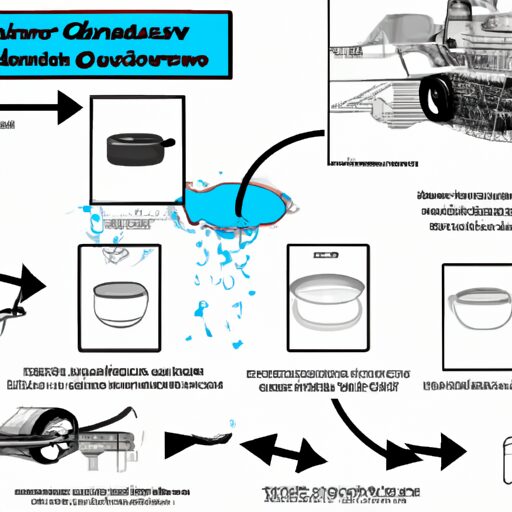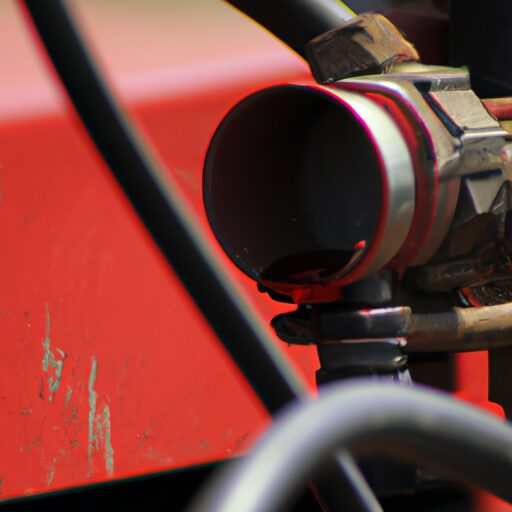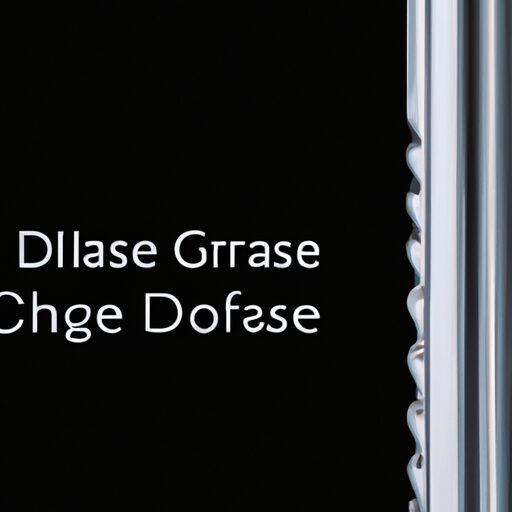How To Check Hydraulic Fluid On Cub Cadet Zero Turn
In the realm of lawn maintenance, ensuring proper functioning and longevity of machinery is paramount. The hydraulic system plays a crucial role in the operation of zero turn mowers, such as the Cub Cadet model. Like veins carrying life-sustaining blood throughout a body, hydraulic fluid enables efficient transmission of power within the machine. Consequently, it becomes imperative to regularly inspect and maintain the hydraulic fluid level to prevent potential malfunctions or damage.
This article aims to provide a comprehensive guide on how to check the hydraulic fluid on a Cub Cadet zero turn mower. With an objective and technical approach, this piece will detail step-by-step instructions for locating the hydraulic fluid reservoir, preparing the mower for inspection, checking the fluid level accurately, addressing any deficiencies through addition or replacement of fluid if necessary, and conducting a thorough examination for leaks or damage. Furthermore, pertinent maintenance tips will be provided to promote optimal performance and extend the lifespan of this essential component. By adhering to these guidelines, individuals seeking understanding can effectively ensure their Cub Cadet zero turn mower’s hydraulic system remains in optimal condition.
Gather the Necessary Tools and Materials
To effectively check the hydraulic fluid on a Cub Cadet zero turn, it is essential to gather the necessary tools and materials required for this task. Checking the hydraulic fluid level is an integral part of the maintenance of the hydraulic system in order to ensure optimal performance and prevent potential issues. To begin, you will need a clean cloth or rag to wipe away any dirt or debris from the reservoir cap and surrounding area. Additionally, a pair of gloves is recommended to protect your hands from any potential spills or contact with the fluid.
In addition to these items, it is important to have a flashlight on hand, as locating the hydraulic fluid reservoir may require some visibility assistance in tight spaces. A small funnel can also be useful when adding or topping off hydraulic fluid if needed. Lastly, it is advisable to have a suitable replacement hydraulic fluid readily available in case replenishment becomes necessary.
Once all these tools and materials are gathered, you can proceed with confidence in checking the hydraulic fluid level on your Cub Cadet zero turn.
Locate the Hydraulic Fluid Reservoir
Located underneath the machine’s body, an essential component awaits discovery – the reservoir housing the lifeblood of its hydraulic system. To effectively check the hydraulic fluid on a Cub Cadet zero turn mower, it is crucial to first locate this vital part. Here are three key steps to guide you in finding the hydraulic fluid reservoir:
-
Check fluid color: The hydraulic fluid should have a clear and consistent color. Any discoloration such as brown or milky appearance may indicate contamination and require further investigation.
-
Check fluid temperature: It is important to assess the temperature of the hydraulic fluid before inspection. Ideally, it should be warm but not excessively hot, as extremely high temperatures can affect its performance and potentially damage the system.
-
Locate the reservoir: On most Cub Cadet zero turn mowers, you can find the hydraulic fluid reservoir positioned near or under the seat area. It may resemble a small rectangular or cylindrical container with a cap for easy access.
By following these steps and locating the hydraulic fluid reservoir, you will be ready to proceed with preparing your mower for inspection without delay.
Prepare the Mower for Inspection
Before commencing the inspection, it is necessary to adequately prepare the mower for assessment by carrying out a series of essential steps. Firstly, it is crucial to clean the mower thoroughly before proceeding with the inspection. This involves removing any debris or dirt that may have accumulated on the exterior surfaces of the machine, as well as clearing away any obstructions around the hydraulic fluid reservoir. By doing so, a clear and unobstructed view of the reservoir can be obtained, facilitating an accurate assessment of its condition.
Additionally, it is important to wear protective gloves during the inspection process. Hydraulic fluid can be potentially harmful if it comes into contact with bare skin due to its chemical composition. Wearing protective gloves not only ensures personal safety but also prevents contamination of the fluid itself.
By adhering to these preparation guidelines, one can approach inspecting the hydraulic fluid reservoir on a Cub Cadet zero turn mower in a systematic and methodical manner. With a clean and unobstructed view and proper protection in place, one can now proceed to check the fluid level in order to determine if any maintenance or adjustments are required.
Check the Fluid Level
One important step in the inspection process involves assessing the level of hydraulic fluid in the reservoir of a Cub Cadet zero turn mower. Checking the fluid level is crucial because if it is too low, it can affect the mower’s performance and potentially damage its internal components. To determine the fluid level, locate the hydraulic fluid reservoir, usually positioned near the engine or under the seat. Remove any debris or dirt around the reservoir cap to prevent contamination. Open the cap and visually inspect whether there is enough fluid inside. If necessary, use a dipstick or sight glass to get an accurate measurement.
Some common signs that indicate low hydraulic fluid include sluggish operation, decreased power, and unusual noises coming from the mower during operation. Troubleshooting these issues may involve checking other parts of the mower system as well, such as belts and filters.
In conclusion, checking the hydraulic fluid level is an essential part of maintaining a Cub Cadet zero turn mower. By identifying any potential problems early on, users can take appropriate action to add or replace fluid if necessary for optimal performance in subsequent sections about adding or replacing fluids without writing ‘step’.
Add or Replace Fluid if Necessary
To ensure optimal performance of the mower, it is essential to add or replace the hydraulic fluid if necessary, as neglecting this maintenance task could potentially lead to undesirable consequences down the line. One important aspect to consider is how to change hydraulic fluid on a Cub Cadet zero turn. Before adding or replacing hydraulic fluid, it is crucial to identify signs of low hydraulic fluid. These signs may include abnormal noise during operation, reduced power and speed, and erratic movement of the mower. If any of these symptoms are observed, it is likely that the hydraulic fluid level needs attention.
To add or replace hydraulic fluid on a Cub Cadet zero turn, start by locating the fill reservoir. The location may vary depending on the specific model but can generally be found near the engine compartment or under a removable panel. Once located, remove the cap from the fill reservoir and check for any debris or contaminants before proceeding. If necessary, clean out any foreign materials using a lint-free cloth.
Next, slowly pour in new hydraulic fluid until it reaches the recommended level indicated by a dipstick or sight glass. It is crucial not to overfill as this can cause damage to internal components. After filling with new fluid, securely tighten the cap back onto the fill reservoir.
In conclusion, understanding how to change hydraulic fluid and recognizing signs of low fluid levels are important steps in maintaining a Cub Cadet zero turn mower’s performance. By following these guidelines for adding or replacing hydraulic fluid when necessary ensures that potential issues related to low fluids are mitigated effectively.
Moving forward into inspecting for leaks or damage…
Inspect for Leaks or Damage
Inspecting for leaks or damage is an essential step in ensuring the proper functioning and longevity of a zero turn mower. It allows you to identify any issues with the hydraulic system that may lead to fluid leaks or potential damage. There are several common causes of hydraulic fluid leaks, including worn-out seals, loose connections, or damaged hoses. To repair hydraulic fluid leaks, it is important to first locate the source of the leak. This can be done by visually inspecting all components of the hydraulic system, such as hoses, fittings, and cylinders. Once the source is identified, you can proceed with repairing or replacing the damaged part. Depending on the severity of the leak, this may involve tightening loose connections, replacing worn-out seals or hoses, or even rebuilding entire hydraulic cylinders if necessary.
By regularly inspecting for leaks or damage and promptly addressing any issues found, you can prevent further damage to your zero turn mower’s hydraulic system and ensure its continued optimal performance. Now let’s move on to a recap of what we’ve covered so far and some maintenance tips to keep your zero turn mower running smoothly.
Recap and Maintenance Tips
In reviewing the information presented thus far, it is imperative to highlight the significance of regular maintenance practices and offer guidance on how to uphold the optimal functioning of your zero-turn mower. Adhering to a proper maintenance schedule ensures that your machine operates efficiently and prolongs its lifespan. Additionally, troubleshooting common issues promptly can prevent further damage and costly repairs.
To maintain your zero-turn mower effectively, it is vital to follow a recommended maintenance schedule. This includes regularly checking and replacing hydraulic fluid as needed, inspecting for leaks or damage, cleaning debris from filters and cooling fins, lubricating moving parts, and sharpening or replacing blades when necessary.
Troubleshooting common issues may involve addressing problems such as loss of power or performance, uneven cutting height, or difficulty in turning. It is essential to refer to the manufacturer’s manual for specific troubleshooting steps tailored to your model.
To help you better understand the maintenance practices mentioned above, here is a table outlining a sample maintenance schedule:
| Maintenance Task | Frequency |
|---|---|
| Check hydraulic fluid | Every 25 hours |
| Inspect for leaks/damage | Every 10 hours |
| Clean filters/cooling fins | Every 50 hours |
| Sharpen/replace blades | As needed |
By following this maintenance schedule and promptly addressing any common issues that arise during operation, you can ensure that your Cub Cadet zero-turn mower remains in optimal condition for years to come.
Frequently Asked Questions
How often should I check the hydraulic fluid on my Cub Cadet zero turn mower?
Regularly checking the hydraulic fluid on your Cub Cadet zero turn mower is crucial for maintaining the hydraulic system. This helps troubleshoot common issues and ensures proper functioning of the system.
What type of hydraulic fluid should I use for my Cub Cadet zero turn mower?
When selecting hydraulic fluid for a Cub Cadet zero turn mower, it is important to follow the manufacturer’s recommendations. Properly filling the hydraulic fluid involves identifying the correct type and ensuring it meets the required specifications for optimal performance and longevity of the mower.
Can I use any other fluid instead of hydraulic fluid for my mower?
Using any alternative fluids instead of hydraulic fluid for your mower may seem like a brilliant idea, but it can lead to potential risks. These risks include damage to the system, decreased performance, and costly repairs.
Is it normal for the hydraulic fluid level to vary depending on the temperature?
The hydraulic fluid level in a cub cadet zero turn mower can vary depending on the temperature. Temperature affects the viscosity of the fluid, causing it to expand or contract. This variation is considered normal and should be taken into account when checking the fluid level.
How do I know if there is a leak in the hydraulic fluid system of my Cub Cadet zero turn mower?
To detect hydraulic fluid leaks in a Cub Cadet zero turn mower, inspect the hydraulic system for visible signs of leakage such as puddles or drips. Troubleshoot common hydraulic fluid issues by checking hose connections, seals, and fittings for wear or damage.
Conclusion
In conclusion, checking the hydraulic fluid on a Cub Cadet zero turn mower is an essential maintenance task. By following the steps outlined in this article, you can ensure that your mower’s hydraulic system is functioning properly and avoid any potential damage or leaks. It is recommended to check the fluid level regularly, as low levels can cause poor performance and potential damage to the mower. Interestingly, studies have shown that regular maintenance, including checking hydraulic fluid levels, can extend the lifespan of a zero turn mower by up to 25%.






